FontInfo Version 2.0 Help - 2003-08-03
FontInfo is a program to display a list of the installed fonts.
A text may be previewed in a clipboard memo.
Detailled informations about the font properties are displayed in a table.
The complete set of characters is shown in a table to select special or symbol characters.
Contents
- Usage
- List Of Installed Fonts
- Table Of Font Properties
- Character Table
- Clipboard Edit
- Functions
- How To Support Additional Languages
- Appendix 1: Font Properties
- Illustration 1: Font Size
- Font Properties (sorted by identifier)
- Font Properties (sorted by description)
- Appendix 2: Raster And Vector Fonts
- Appendix 3: Measurements
- References
Usage
List Of Installed Fonts
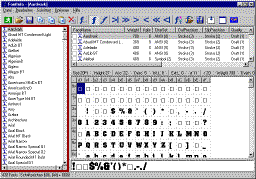
All installed fonts are displayed in alphabetical order. The icon left to the name represents the font type*).
The current font is also used in the table of font properties, the character table and the clipboard edit.
*) See next section
Table Of Font Properties
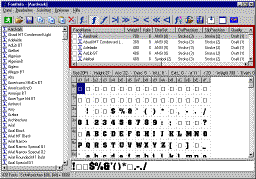
The current font can also be selected in this table.
The icon left to the name represents the font type*).
Displayed values for each font are independent of other properties like size and style.
The table can be sorted by the values of the columns.
*) Following font types are shown:
The table can be sorted by font type (s. Functions).
Character Table
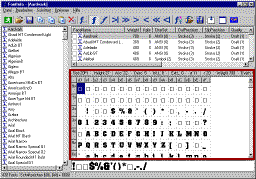
In this table all available characters of the current font are shown.
The selected character can be copied to the clipboard edit. The code of the selected character will be displayed in the status line.
In the header rule on top of the character table values of the current font are shown, which depend on other properties like size and style.
Clipboard Edit

This edit can be used as clipboard or preview of any text to be displayed with the current font.
Functions
- Menu File
-
 Open...
Open... - A dialog window will be opened to load a text to the clipboard edit.
-
 Save...
Save... - A dialog window will be opened to save the contents of the clipboard edit.
-
 Exit...
Exit... - FontInfo will be closed.
- Menu Edit
-
 Cut
Cut - The selected text from the clipboard
memo*) is copied to the system clipboard
and deleted in the clipboard memo.
*) This function is not available, if the character table is focussed. -
 Copy
Copy - If the character table is focussed, the selected character is copied to
the system clipboard, otherwise the selected text from the clipboard memo
is copied to the system clipboard.
-
 Delete
Delete - The selected text in the clipboard memo*)
is deleted.
*) This function is not available, if the character table is focussed. -
 Paste
Paste - The text from the system clipboard is pasted to the
clipboard edit*).
*) This function is not available, if the character table is focussed. - Menu Font
-
 Select...
Select... - Select the current font in a common font dialog.
-
 Bold
Bold - Toggles bold font style on or off.
-
 Italic
Italic - Toggles italic font style on or off.
-
 Submenu Height
Submenu Height -
-
 Minimum
Minimum - Sets the size of the current font to minimum (5 Px).
-
 Decrease large
Decrease large - The size of the current font is decreased by 10 Px.
-
 Decrease
Decrease - The size of the current font is decreased by 1 Px.
-
 Increase
Increase - The size of the current font is increased by 1 Px.
-
 Increase large
Increase large - The size of the current font is increased by 10 Px.
-
 Maximum
Maximum - Sets the size of the current font to maximum (256 Px).
-
-
 Sort by font type
Sort by font type - The table of font properties is sorted by
font type.
The fonts are sorted by name, character set, familiy, pitch and marks. -
 Load font marks
Load font marks - The font marks of the table of font
properties*) are loaded from a text
file.
*) This function is only available, if the table of font properties is visible. -
 Save font marks
Save font marks - The font marks of the table of font
properties*) are saved to a text file.
*) This function is only available, if the table of font properties is visible. -
 Copy character
Copy character - The selected character will be copied from the character
table*) to the clipboard edit.
*) This function is only available, if the character table is visible. - Menu Options
-
 Submenu Language
Submenu Language - One of the supported languages can be selected in this submenu.
Additional languages can be added to this selection by translation (see below.). -
 Submenu View
Submenu View -
-
 List of installed fonts
List of installed fonts - The list of installed fonts will be displayed or hidden.
-
 Table of font properties
Table of font properties - The table of font properties will be displayed or hidden.
-
 Character Table
Character Table - The character table will be displayed or hidden.
-
How To Support Additional Languages
Please follow the instructions step by step.Step 1
Open the initialization file of the application (
*.ini).In section
[Options] edit the key ExtraLanguages:Add an abbreviation
xx conform to
ISO 639-1*) for the new language, for
enumeration use commas.*) This is only a suggestion.
Examples:
ExtraLanguages=xxExtraLanguages=aa,xxSave the initialization file of the application.
Step 2
Start the application.
Enter the name of the new language for all supported languages.
If unknown they can be edited later in the initialization file.
Stop the application.
Step 3
Translate the texts in the created language resource file (
xx.ini).Step 4 (optional)
A symbol can be added to be displayed in the main menu of the application. Otherwise no symbol will be displayed.
Symbol files are managed in the subdirectory
\images.Required properties are:
Format Windows-Bitmap
(*.bmp)Filename
xx.bmpSize 16 x 16 Px.
Transparent color
clFuchsia (RGB 255/000/255).Step 5 (optional)
You can translate the HTML help. If a translation is missing, the english version will be displayed for the new laguage.
Create a copy of the file
"fontinfo.htm" and append the language
abbreviation to the filename:
"fontinfoxx.htm".Add links to the page you have translated in all existing help files.
You can add an icon for the link in the HTML help. Required properties are:
Format "Compuserve Graphics Interchange Format"
(*.gif)Dateiname
xx.gifGröße 72 x 36 Px.
Appendix 1: Font Properties (sorted by identifier) (sorted by description)
Illustration 1: Measures at characters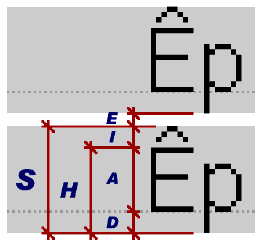
A=Ascent (Upper height)
D=Descent (Lower height)
E=ExternalLeading (External leading)
H=Height (Height)
I=InternalLeading (Internal leading)
S=Size (Size)Font Properties (sorted by identifier)
Ascent Upper heightAveCharWidth Average character widthBreakChar Break characterCharSet (LogFont) Character setCharSet (TextMetric) Character setClipPrecision Clipping precisionDefaultChar Substitute characterDescent Lower heightDigitizedAspectX Horizontal DigitalizationDigitizedAspectY Vertical DigitalizationEscapement Character angleExternalLeading External leadingFaceName Name of the fontFirstChar First characterHeight (LogFont) HeightHeight (TextMetric) HeightInternalLeading Internal leadingItalic (LogFont) ItalicItalic (TextMetric) ItalicLastChar Last characterMaxCharWidth Maximum character widthOrientation Text angleOutPrecision Output precisionOverhang OverhangPitchAndFamily (LogFont) Character pitch and
font familyPitchAndFamily (TextMetric) Pitch and
font familyQuality QualitySize SizeStrikeOut (LogFont) Strike outStruckOut (TextMetric) Strike outUnderlined (LogFont) UnderlineUnderlined (TextMetric) UnderlineWeight (LogFont) WeightWeight (TextMetric) WeightWidth WidthFont Properties (sorted by description)
Average character width
AveCharWidthBreak character
BreakCharCharacter angle
EscapementCharacter set
CharSet (LogFont)Character set
CharSet (TextMetric)Clipping precision
ClipPrecisionExternal leading
ExternalLeadingFirst character
FirstCharHeight
Height (LogFont)Height
Height (TextMetric)Horizontal Digitalization
DigitizedAspectXInternal leading
InternalLeadingItalic
Italic (LogFont)Italic
Italic (TextMetric)Last character
LastCharLower height
DescentMaximum character width
MaxCharWidthName of the font
FaceNameOutput precision
OutPrecisionOverhang
OverhangPitch an font family
PitchAndFamily (LogFont)Pitch an font family
PitchAndFamily (TextMetric)Quality
QualitySize
SizeStrike out
StrikeOut (LogFont)Strike out
StruckOut (TextMetric)Substitute character
DefaultCharText angle
OrientationUnderlined
Underlined (LogFont)Underlined
Underlined (TextMetric)Upper Height
AscentVertikal Digitalization
DigitizedAspectYWidth
WidthWeight
Weight (LogFont)Weight
Weight (TextMetric)Datastructure
LogFont contains fields describing a virtual
font.-
Height (LogFont.lfHeight)(not displayed) - This is the height of the font.
-
Width (LogFont.lfWidth)(not displayed) - This is the average width of the font.
-
Escapement (LogFont.lfEscapement)(not displayed) - This is the angel [1/10°] from the base line by which each character is
rotated.

-
Orientation (LogFont.lfOrientation)(not displayed) - This is the angel [1/10°] between the text base line and the x-axis of
the display device.

-
Weight (LogFont.lfWeight) - This is the font weight, specified in blackened dots of thousand
[].
For some fonts the predefined weight differs from standard (400).
000 DontCare Nothing specified
100 Thin Thin
200 ExtraLight/ UltraLight Very light
300 Light Light
400 Normal/ Regular Normal
500 Medium Medium
600 SemiBold/ DemiBold Semi bold
700 Bold Bold
800 ExtraBold/ UltraBold Very bold
900 Heavy/ Black Black
-
Italic (LogFont.lfItalic) - This value specifies a font predefined with italic style.
See also:Italic (TextMetric.tmItalic) -
Underline (LogFont.lfUnderline)(not displayed) - This value specifies a font predefined with underlined style.
See also:Underlined (TextMetric.tmUnderlined) -
StrikeOut (LogFont.lfStrikeOut)(not displayed) - This value specifies a font predefined with strike out style.
See also:StruckOut (TextMetric.tmStruckOut) -
CharSet (LogFont.lfCharSet) - This value specifies the character set. It is important for the process
of associating a physical font to requested virtual font properties
(font mapping).
The follwing values are predefined. Fonts with other character sets may exist depending on the operating system.
ANSI
- This is the standard Windows text font.

ARABIC(Windows 95)
BALTIC(Windows 95)
CHINESEBIG5
DEFAULT(The font was only mapped by name and size.)
EASTEUROPE(Windows 95)
GB2312
GREEK(Windows 95)
HANGEUL
HEBREW(Windows 95)
JOHAB(Windows 95)
MAC(Windows 95)
OEM(Operating system)
- This is the standard Windows font used to display MS-DOS text, a
character set with ASCII code.
It is different from ANSI set for characters with a code bigger than 127. In this area especially codes for nationalized characters are stored, in ASCII there are also characters for block graphics. ASCII Set also contains characters in the area of control codes (0-31).
Example: "Terminal".
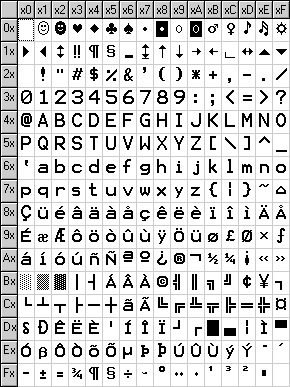
RUSSIAN(Windows 95)
SHIFTJIS
SYMBOL
- This is the standard Windows symbol font.

THAI(Windows 95)
TURKISH(Windows 95)
- This is the standard Windows text font.
-
OutPrecision (LogFont.lfOutPrecision) - This value specifies the output precision to control how exact the
output matches requested font properties as height, pitch etc.
CHARACTERNot used.
DEFAULTStandard font mapping behavior.
DEVICEFont mapping prefers system fonts, if several font with the same name are available.
OUTLINE
Windows NT: Font mapping selects a TrueType- or other outline font.
Windows 95: Not used.
RASTERFont mapping prefers raster fonts, if several font with the same name are available.
STRINGThis value is not used by font mapping, but is always returned when enumerating raster fonts.
STROKE
Windows NT: This value is not used by font mapping, but is always returned when enumerating TrueType-, outline or vector fonts.
Windows 95: Font mapping selects a vector font. This value is returned when enumerating TrueType- or vector fonts.
TT_ONLYFont mapping selects only TrueType fonts. If no such fonts are available standard mapping process is used.
TTFont mapping prefers TrueType fonts, if several font with the same name are available.
-
ClipPrecision (LogFont.lfClipPrecision) - This value specifies the clipping precision to control how partially
hiddem characters are displayed.
DEFAULTStandard clipping behavior.
CHARACTERNot used.
STROKEThis value is not used by font mapping, but is always returned when enumerating raster, vector or TrueType fonts.
Windows NT: For compatibility this value is always returned when enumerating fonts.
MASKNot used.
EMBEDDEDThis value has to be set to use an embedded, read-only font.
LH_ANGLESIf this value is set, the rotation of fonts depends on whether a left- or righthanded coordinate system is used. If the value is not set, all system fonts are rotated counterclockwise, all other fonts rotation depends on coordinate system.
TT_ALWAYSNot used.
-
Quality (LogFont.lfQuality) - This value specifies the display quality to control how exact the
graphic device interface (GDI) has to match logical font properties with
a physical font.
DEFAULTQuality does not matter.
DRAFTQuality is less important than PROOF.
Raster fonts may be scaled. Bold, italic, underlined and struck out font variants may be synthezised.
PROOFQuality of single characters is more important than matching other font properties.
Raster fonts may not be scaled. Bold, italic, underlined and struck out font variants may be synthezised.
-
PitchAndFamily (LogFont.lfPitchAndFamily) - This value specifies a font with either fixed or variable character
width.
DEFAULTNot used.
FIXEDFixed character width (typewriter font)

VARIABLEVariable character width (proportional)

The value also specifies the family, to request a font by a general description type.
DECORATIVENovelty fonts, e.g. Old English.

DONTCAREUnknown or unimportant.
MODERNFonts with constant stroke width with or without serifs.

ROMANFonts with variable stroke width and with serifs.

SCRIPTFonts looking like handwriting.

SWISSFonts with variable stroke width and without serifs.

-
FaceName (LogFont.lfFacename) - This is name of the font with a maximum length ot 31 letters.
-
Size (Font.Size) - This values specifies the size of the font measured in Point [Pt].
See also:
Illustration 1: Font Size
Measurements: Point [pt]
Measurements: Font Size Names
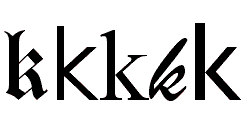
The same character will be displayed with variable size, if different fonts are used (24Pt at 300 dpi).
Data structure
TextMetric contains fields to describe a physical
font.-
Height (TextMetric.tmHeight) - This value specifies the height of the font measured in dots [Px].
It is the total of upper and lower height.
See also: Illustration 1: Font Size -
Ascent (TextMetric.tmAscent) - This value specifies the upper height of the font measured in dots
[Px]. This is the height above the base line of the font.
The sum of upper and lower height is the total height.
See also: Illustration 1: Font Size -
Descent (TextMetric.tmDescent) - This value specifies the lower height of the font measured in dots
[Px]. This is the height below the base line of the font.
The sum of upper and lower height is the total height.
See also: Illustration 1: Font Size -
InternalLeading (TextMetric.tmInternalLeading) - This value specifies the internal leading in dots [Px].
This is the white space inside of the font size, which is reserved for accent and other diacritical signs.
See also: Illustration 1: Font Size -
ExternalLeading (TextMetric.ExternalLeading) - This value specifies the internal leading in dots [Px].
This is the white space outside of the font size, which is inserted between text lines.
See also: Illustration 1: Font Size -
AveCharWidth (TextMetric.tmAveCharWidth) - This value specifies the average character width in dots [Px].
It is generally defined by the width of the character "x".
The value does not contain the overhang necessary for bold or italic characters. -
MaxCharWidth (TextMetric.tmMaxCharWidth) - This value specifies the maximum character width in dots [Px].
-
Weight (TextMetric.tmWeight) - This is the font weight, specified in blackened dots of thousand
[].
See also:Weight (LogFont.lfWeight) -
Overhang (TextMetric.tmOverhang) - This value specifies the extra width in dots [Px], which will be added
for some sythezised fonts.
For bold sythezised fonts the character spacing will be increased and the character will be overpainted with a certain offset, for italic fonts the text will be sheared.
For bold fonts the value specifies the offset when overpainting, for italic fonts how much the top of the cell rect is sheared against the bottom.
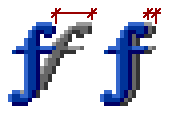
-
DigitizedAspectX (TextMetric.tmDigitizedAspectX) - Specifies the horizontal digitalization factor of the device in dots
per inch [dpi] the font was designed for.
-
DigitizedAspectY (TextMetric.tmDigitizedAspectY) - Specifies the horizontal digitalization factor of the device in dots
per inch [dpi] the font was designed for.
The aspect ratio of the device can be calculated as quotient of the horizontal and the vertical value.
-
FirstChar (TextMetric.tmFirstChar) - This value specifies the code of the first character defined in the
font.
For fonts with the ANSI character set this is usually the character with the code #0032, the space character.
Fonts with OEM character set start with character #0000.
-
LastChar (TextMetric.tmLastChar) - This value specifies the code of the last character defined in the
font.
-
DefaultChar (TextMetric.tmDefaultChar) - This value specifies the code of the substitute character in the
font.
-
BreakChar (TextMetric.tmBreakChar) - This value specifies the code of the break character in the
font, used for text justification.
-
Italic (TextMetric.tmItalic) - This value specifies an italic font.
See also:Italic (LogFont.lfItalic) -
Underlined (TextMetric.tmUnderlined) - This value specifies an underlined font.
See also:Underlined (LogFont.lfUnderlined) -
StruckOut (TextMetric.tmStruckOut) - This value specifies a struck out font.
See also:StrikeOut (LogFont.lfStrikeOut) -
PitchAndFamily (TextMetric.tmPitchAndFamily) - This values gives information about character width, technology and
family of the font.
The font family value is the same as in the LogFont data structure.
FIXED_PITCHThis value indicates a font with variable (!) pitch.
Note that this is the opposite of the constant name.
VECTORVector font
TRUETYPETrueType font
DEVICEDevice font
See also:PitchAndFamily (LogFont.lfPitchAndFamily) -
CharSet (TextMetric.tmCharSet)(not displayed) - This value specifies the character set.
See also:CharSet (LogFont.lfCharset)
Appendix 2: Raster And Vector Fonts
Raster FontsCharacters are stored in a raster font as small bitmaps.
For each supported size an extra bitmap character set exists. For fonts not supported the next smaller bitmap character set is selected and only the line height increased.
Typical raster fonts are "MS Sans Serif", "MS Sans Serif" or "Terminal".
Vector Fonts
Bitmaps shown by vector fonts will be drawn when displayed according to the requested size using drawing instructions. First a closed outline is drawn and then filled with color.
For TrueType fonts additional instructions (hints) are possible to enhance the displayed quality of fonts.
Appendix 3: Measurements
Point [Pt]One point measures 1/72 inch, that is (25,4 mm / 72) = 0,352778 mm.
This is the standard unit used for specification of font size.
Dots [Px]
The extent of one dot depends on the display device.
The abbreviation of this unit is "Px" from "pixel" for "picture element".
Pica [Pica]
This unit is especially used when printing.
One Pica measures 12 point (4,23 mm).
Dots per inch [dpi]
This unit measures the resolution of the display device.
The abbreviation of this unit is "dpi".
Windows always uses a resolution of 96 dpi with display modus "Small fonts" or 120 dpi with "Large fonts".
Characters per inch [cpi]
This measurement is used for specification of the font of typewriters.
Often a size of 10 or 12 cpi was used for typewriters.
Font Size Names
Some names are used for font sizes.
Perl 5 Pt
PerlNonpareille 6 Pt
NonpareilleKolonel (Mignon) 7 Pt
Kolonel (Mignon)Petit 8 Pt
PetitBorgis 9 Pt
BorgisKorpus (Garmond) 10 Pt
Korpus (Garmond)Cicero 12 Pt
CiceroQuellenangaben
[1] Dokumentation des MS Windows Application Programmers Interface (API)[2] SelfHTML (HTML-Dateien selbst erstellen)
[3] rororo Lexikon, Taschenbuchausgabe
[4] Benutzerhandbuch zum MS TrueType-Schriftarten-Paket für Windows